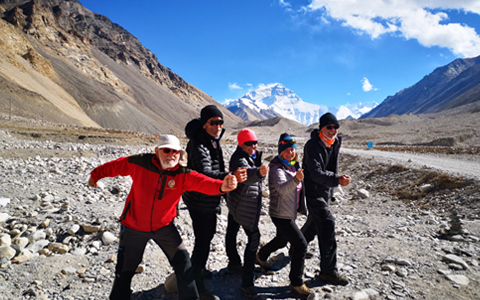One of the major concerns that some people have regarding cycling tours of Tibet is whether it is actually safe to cycle across the vast plateau region. Tibet is a vast land that lies at an average altitude of around 4,800 meters above sea level. Vast plains stretch for hundreds of miles in all directions, varying weather conditions prevail, depending on the time of year you are traveling, and a number of wild animals roam the woodlands and plains of the plateau.
Safety is a very valid concern for potential cyclists that are hoping to fulfil a lifetime dream of cycling across the world’s highest plateau. Whether it is the animals, the weather, or the altitude that worries you about cycling in Tibet, we can easily put your mind at ease when it comes to safety.
Cycling in Tibet is Safe and Feasible
Generally, cycling in Tibet is as safe as cycling your own streets in your home town. Probably safer, considering the almost negligible amount of traffic that can be seen on the plateau’s high roads. Cycling tours of Tibet are becoming a popular option for cycling enthusiasts from around the world, and you can choose from a range of tours, from short 6-day tours of Lhasa and the surrounding countryside to 21-day tours from Lhasa to Kathmandu or awesome 22-45 day long tours that run from mainland China into Tibet from all directions.
Road Condition in Tibet is Greatly Improved
Road conditions in Tibet are far from what they used to be, and have been greatly improved over the last few years. It was not too long ago that the immense Friendship Highway, which runs from Lhasa to Gyirong Port, was partially just dirt and gravel roads along many stretches. Not ideal for cycling, these stretches of the G318 National Highway have been updated to fully paved asphalt roads, making the entire length of the Friendship Highway a paved road.
 Road condition in Tibet is greatly improved.
Road condition in Tibet is greatly improved.Other roads have also been improved in Tibet, and work on road improvements across the plateau are ongoing all the time. The poor road that once led across the Nyenchen Tanglha Mountains to Lake Namtso now has a nice, smooth asphalt surface for the whole length. You may want to get a lift up over the high pass though, as it is a little bit steep.
The roads to Tsedang in Lhoka are also improved, with high-grade highway for much of the route to the cradle of Tibetan civilization. And many of the other smaller roads that you might encounter are now paved, though to a somewhat lesser degree than the major highways. Even part of the route to Everest Base Camp in Shigatse Prefecture has asphalt surfaces, though the latter part of this popular road is still little more than a dirt track.
 Cycling in Everest Base Camp latter part dirt track.
Cycling in Everest Base Camp latter part dirt track.Multiple Cycling Routes Available for Different Levels of Fitness
There are a huge number of routes that you can choose from for your adventurous cycling expedition. You can take a shorter 6-day cycling tour from Lhasa to Ganden, which gives you a beautiful and leisurely look at the countryside that surrounds the Tibetan capital. For anyone not used to cycling in high altitudes, this combined tour, which has a few days of acclimatization before the two-day ride to Ganden Monastery and back, is the perfect short trip. Another shorter trip is the 15-day tour that includes a cycling tour from Lhasa to Ganden Monastery, Lake Namtso, Samye Monastery, and Tsedang, including visits to Yangpachen and Yumbulakang.
You can also take on the longer 21-day adventure across the vast Tibetan plateau. This amazing expedition takes you from the shining city of Lhasa to the exotic capital of Nepal, Kathmandu. Cycling across the expanse of the Tibetan plateau, stopping in the major towns for sightseeing and taking a night out at the famous EBC, this is the ultimate in high-altitude adventures.
 Cycling across Tibetan plateau.
Cycling across Tibetan plateau.Longer tours than that also exist, including tours that allow you to cycle from Chengdu to Lhasa, Xining to Lhasa, and Yunnan to Lhasa. These longer tours do have more of a journey ahead, taking anywhere from 21 to 30 days, depending on your itinerary and route.
Tour Agency Will Assure Your Safety Along the Trip
Your travel agency is actually responsible for your safety while you are cycling in Tibet, and we do our utmost to ensure that you are kept safe and well looked after for your entire tour. As you ride along the plateau, your guide is with you in the support vehicle, and you will have constant contact with him at all times.
 Our Tibet Tour agency support vehicle will assure your safety.
Our Tibet Tour agency support vehicle will assure your safety.Your guide and support vehicle driver will be waiting for you daily at each stop that you have listed in your itinerary, and will be able to handle any issues that come up, from accommodation problems to accidents and cycle problems. They will also carry the equipment you are bringing with you but do not want to carry on the bike.
How to Enjoy a Pleasant Cycling Tour in Tibet?
There are ways to make sure that you can enjoy the cycling tour on the plateau to the fullest. Before you depart from your home country, you should make sure that you are well prepared for the tour you are undertaking, and ready for the greatest adventure of your life.
Choose the Best Time for Cycling
Knowing when to cycle in Tibet is a major concern, and one that you should pay particular attention to. While the plateau does not get as cold as many people think, winter is a little too cold for cycling. And the roads can get a little icy, making it dangerous for some routes. Summer can be a little wet in some areas too, but overall is one of the best times for touring Tibet by bike.
 June to September is the optimum weather for cycling tours.
June to September is the optimum weather for cycling tours.In general, the period from April to October is the best time for touring by Bike in Tibet. June to September is the optimum time period for cycling tours, as this is when the weather in Tibet is most favorable for cycling. Despite it being the monsoon season for part of the peak period of summer, there is little rain across most of the plateau that will upset a cycling tour too much.
Choose the Most Suitable Cycling Route
Another consideration to take great care over is your choice of which route to take. Some routes in and to Tibet are harder than others, and you should make sure that your route is suitable for your level of skill and experience. For those not used to cycling along high altitude regions of the world, then a shorter trip around Lhasa or to Tsedang or Namtso would be the best option. This would give you the chance to get used to cycling at high altitudes and in thinner atmospheric conditions.
For those that have a little more experience in cycling, you can opt for some of the harder cycling tours of Tibet, such as the long 21-day adventure across the plateau from Lhasa to Kathmandu. This takes you up to some of the highest road passes in the world, and brings you within reach of Tibet’s most spectacular attraction ever, the famous Everest Base Camp.
For those with a real sense of adventure, you can try out the long cycling routes from mainland China to Lhasa. Much harder than the route across the plateau, these are really only for very experienced cyclists, and take you along the roads that lead from Xining, Yunnan, Sichuan, and Kashgar to Lhasa.
Adjust to High Altitude Before Cycling
Before you can take on the tour across the plateau - or even the shorter trips to Ganden, Namtso, or Tsedang - you need to get used to the higher altitudes. All tours to Tibet include a couple of days of acclimatization in the Tibetan capital, so that you can get used to the increased altitude and lower oxygen content of the air. This is hugely important, as it can help you adjust properly and reduce the risk of altitude sickness while on your tour.
Acclimatization usually means that you will feel some of the symptoms of altitude sickness while your body adjusts to the increase in elevation. This can include headaches, dizziness, and nausea, but usually abates after a couple of days. Once you have adjusted to the altitude, you are ready to start your pic adventure cycling in Tibet.
Join in a Well-Organized Tour with Back-Up
Independent travel is not permitted in Tibet, and this includes those on cycling tours. You will need to book a pre-arranged tour of the region with a registered Tibetan travel agency. Once you have booked your tour with us, we will handle all of the details for permits and passes, and arrange your tour itinerary, guide, and support vehicle with driver.
All of our cycling tours across the plateau have excellent 24-hour support available from our consultants, as well as your personal support team and vehicle, which will be traveling with you as you ride across Tibet. We make sure that all our cycling tours are well organized, and have complete back up for any eventuality.
Conclusion
Cycling across Tibet is the journey of a lifetime, and is as safe as cycling down your own road, but with higher altitudes and better views. If you have concerns about your safety in Tibet, you can be reassured that this high-altitude land is one of the friendliest places in the world. And with our excellent support services and customized tour itineraries, you are in good hands for your epic overland adventure on the Roof of the World.

























 Road condition in Tibet is greatly improved.
Road condition in Tibet is greatly improved. Cycling in Everest Base Camp latter part dirt track.
Cycling in Everest Base Camp latter part dirt track. Cycling across Tibetan plateau.
Cycling across Tibetan plateau. Our Tibet Tour agency support vehicle will assure your safety.
Our Tibet Tour agency support vehicle will assure your safety. June to September is the optimum weather for cycling tours.
June to September is the optimum weather for cycling tours.









Ask a Quick Question